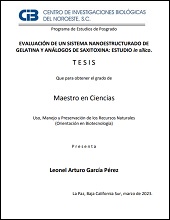Mostrar el registro sencillo del ítem
EVALUACIÓN DE UN SISTEMA NANOESTRUCTURADO DE GELATINA Y ANÁLOGOS DE SAXITOXINA: ESTUDIO in sílico
| dc.contributor.advisor | ESTRADA MUÑOZ, NORMA ANGELICA | |
| dc.contributor.advisor | HERNANDEZ ADAME, LUIS | |
| dc.contributor.author | García Pérez, Leonel Arturo | |
| dc.date.issued | 2023 | |
| dc.identifier | https://cibnor.repositorioinstitucional.mx/jspui/handle/1001/2724 | |
| dc.identifier.uri | http://dspace.cibnor.mx:8080/handle/123456789/3170 | |
| dc.description.abstract | "Las toxinas paralizantes (TP) provenientes de dinoflagelados marinos, son un grupo de alcaloides neurotóxicos. Las TP están conformadas por una estructura heterocíclica con dos grupos guanidina, los cuales son responsables de la polaridad positiva y de su propiedad bloqueadora de canales de sodio dependientes de voltaje en vertebrados en un pH de 7. Estas propiedades han sido motivo de estudio en el campo biomédico, principalmente para tratamientos de enfermedades relacionadas con el sistema nervioso. Sin embargo, estos alcaloides presentan una elevada toxicidad por lo que se requiere controlar de manera efectiva la dosis terapéutica. Una alternativa es utilizar nanoacarreadores como la gelatina tipo A (GelNP) la cual es un biopolímero natural derivado de la hidrólisis del colágeno, cuyo uso en el campo biomédico es muy versátil debido a su biocompatibilidad y propiedades coloidales. En este sentido, el presente trabajo pretende hacer predicciones in silico de un novedoso sistema nanoestructurado entre nanopartículas de GelNP como vehículo de transporte y las TP, con el objetivo de modular el tiempo de acción y disminuir su toxicidad. Las predicciones se hicieron desarrollando el modelado, la simulación y la visualización de las mismas. Con el programa Avogadro, se modelaron 36 análogos de las TP, los cuales se identifican por sus sustituyentes, así como; de igual manera, se consideró como modelo de la gelatina tipo A, un monómero y un polímero de la misma. Se corrigieron las distancias y ángulos de enlace de los átomos de estas moléculas con el método de optimización del campo de fuerza universal (UFF), así como, se les asignó la carga neta correspondiente. La visualización se llevó a cabo con el programa Chimera 1.5.3. Finalmente, se evaluó el acoplamiento molecular in silico (docking) y la afinidad de las TP y la GelNPs con el programa Molegro Virtual Docker (MVD). Los resultados indican que las TP que tienen una mayor afinidad con la GelNP son la Saxitoxina (STX), Carbamatos 1 y 3 (C1 y C3), y los epímeros Goniautoxinas 2 y 3 (GTX 2/3). Esto nos demuestra que dichas toxinas son candidatos óptimos para la síntesis del complejo nanoestructurado." | es |
| dc.format | es | |
| dc.language.iso | spa | es |
| dc.publisher | Centro de Investigaciones Biológicas del Noroeste, S.C. | es |
| dc.rights | Acceso abierto | es |
| dc.subject | Toxinas paralizantes, gelatina tipo A, nanoacarreadores, acoplamiento molecular | es |
| dc.subject | Paralyzing toxins, type A gelatin, nanocarriers, molecular docking | es |
| dc.title | EVALUACIÓN DE UN SISTEMA NANOESTRUCTURADO DE GELATINA Y ANÁLOGOS DE SAXITOXINA: ESTUDIO in sílico | es |
| dc.type | masterThesis | es |
| dc.dirtesis.grado | Maestría en Ciencias en el Uso, Manejo y Preservación de los Recursos Naturales | es |
| dc.dirtesis.disciplina | Biotecnología | es |
| dc.dirtesis.universidad | Centro de Investigaciones Biológicas del Noroeste, S.C. | es |
| dc.dirtesis.facultad | Posgrado en Recursos Naturales | es |
| dc.description.abstracten | "Paralyzing toxins (PT) from marine dinoflagellates are a group of neurotoxic alkaloids. PTs are heterocyclic structures with two guanidine groups responsible for their positive polarity and blocking properties of voltage-gated sodium channels in vertebrates at a physiological pH of 7. These properties have been the subject of study in the biomedical field, mainly for treating diseases related to the nervous system. However, these alkaloids have high toxicity, so it is necessary to control the therapeutic doses effectively. An alternative is to use nanocarriers such as type A gelatin (GelNP), a natural biopolymer derived from the hydrolysis of collagen, whose use in the biomedical field is very versatile due to its biocompatibility and colloidal properties. In this sense, the present work intends to make in silico predictions of a novel nanostructured system between GelNP nanoparticles as a transport vehicle and PT to modulate the action time and reduce its toxicity. The predictions were made using three principal tools to determine: 1) modeling, 2) simulation, and 3) visualization. With the Avogadro program, we modeled 36 PT analogs, identified by the substitution in the radical groups and the monomer and polymer of type A gelatin. The distances and bond angles of the atoms were corrected with the optimization method of the universal force field (UFF), and the corresponding net charge was assigned to them. They were visualized using the Chimera 1.5.3 program. The molecular coupling (docking) and the affinity of the PTs and the GelNPs were evaluated with the Molegro Virtual Docker program. The results indicate that the PTs that have a higher affinity with GelNP are Saxitoxin (STX), Carbamates 1 and 3 (C1 and C3), and the Goniautotoxins 2 and 3 (GTX 2/3) epimers. These toxins are optimal candidates for the synthesis of the nanostructured complex." | es |

